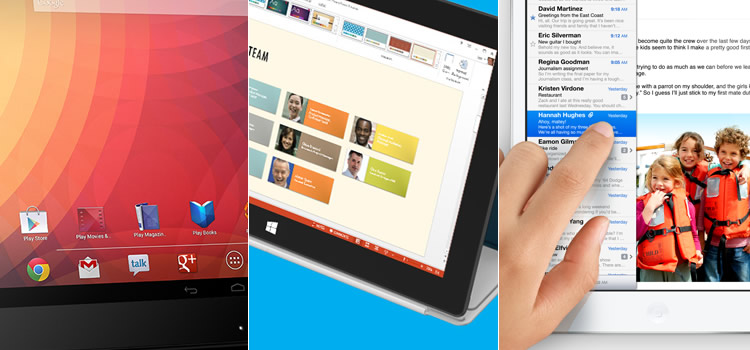The tablet market doesn’t look very different than it did a year ago from the perspective of who’s doing well and who’s not. And yet quite a bit has changed in the last twelve months. Apple is still the undisputed leader with an astounding 58 million iPads sold in 2012, but in that timeframe we’ve also seen a handful of smartphone and computer makers who dipped their toes in the market take a step to the side and reconsider their strategy.
You can count HTC and BlackBerry in that group -- neither of which has a tablet in shelves right now but have openly admitted an interest in the market. HP, on the other hand, is jumping back with an inexpensive Android device for the first time since the TouchPad / webOS fiasco. Others like Toshiba, Motorola and Lenovo have stuck around with shy efforts to remain in the game and similarly minor results.
Perhaps the most exciting developments came towards the end of 2012 and beginning of 2013 from the usual big guys: Google released the Nexus 10 and updated the Nexus 7, Apple launched a smaller and cheaper iPad mini, while Microsoft went all in with the Surface RT and Pro.
With Mobile World Congress in the rear view mirror it’s time to revisit our list of favorite tablets. As usual, we've compiled a comparative table with what we consider are the best options either currently available or announced so far, complete with metascores from our Product Finder engine and review links.
More Than Just Specs
Here's the deal: all of the above are capable devices hardware-wise, some edging out others in areas like processing power or connectivity. If all you care about is specs, it shouldn’t be too hard picking out a winner. But you should know that when you are buying a tablet you’re also buying into a particular ecosystem. The fastest processor or sharpest screen is worthless if you can’t use them for the things you want.
In that regard, if you strictly adhere to pure tablets, iOS often comes out on top. Not because it has the largest app catalog of all -- the total number of apps is a meaningless metric after a certain threshold -- but because high profile apps and games usually launch for Apple’s platform first and sometimes remain a exclusive for a while.
Android isn’t that far behind, though, so it’s your job to do a little research based on what you’re going to be using the tablet for. Microsoft is still building the app catalog for Windows RT, and for now it can’t really match iOS or Android.
And then, well, there’s Windows 8 which will run the same apps as your desktop PC on a very capable, albeit expensive, Surface Pro tablet. Here the ecosystem is everything you run on the desktop, which poses a very interesting proposition for productivity and business apps alike.
Making Some Picks
That's the gist of it when it comes to platforms. For iOS your only option is an iPad or iPad Mini, while Windows users have a handful of alternatives to choose from but none that can match the compact form and sleek keyboard cover of the Surface -- not until Haswell arrives. For Android you have a wealth of options but if you care about OS updates I wouldn't get anything that doesn't have the Nexus brand on it.
If I buy a tablet I intend to keep it for at least 2-3 years, if not more, and with other brands you usually get updates late or not at all. This may change in the future but until then better to be safe than sorry.
With all of the above considerations it's a matter of budget and choosing a form factor that fits your needs. In the 10-inch category the iPad is a popular choice. It offers options like 3G/4G connectivity that Google's counterpart does not, plus the software ecosystem edge mentioned earlier. If that isn't important to you the Samsung-made Nexus 10 offers similar specs and solid build quality for around $100 less. The Surface RT just doesn't measure up in this group, and while we like the Surface Pro, at $899 without the keyboard (or $999 with) it's dangerously close to ultrabook territory.
It's a similar situation in the 7-inch category -- basically a platform choice -- but with a starting price of just $199 the Nexus 7 is definitely our budget pick and is an all around great performer.
Amazon’s Kindle is still a solid choice but the main reason it made waves when it first arrived was because it was better and cheaper than the competition at the time. Google has taken that advantage away with the Nexus 7.
Strictly for Reading
A honorable mention goes to the Amazon Kindle Paperwhite, the latest entry in the Kindle e-reader family and a true favorite among book buffs. The Wi-Fi only version is $139 or $179 for the 3G version with free connectivity. The Paperwhite will let you save hundreds of books in memory, offers a massive list of titles, and the battery will last for weeks, not to mention it weighs about half of the lightest of tablets. Evidently, the Kindle Paperwhite doesn't compare directly to the tablets above but if you are a heavy reader and absolutely prefer your laptop over a tablet when you are on the go, this might just make more sense.
